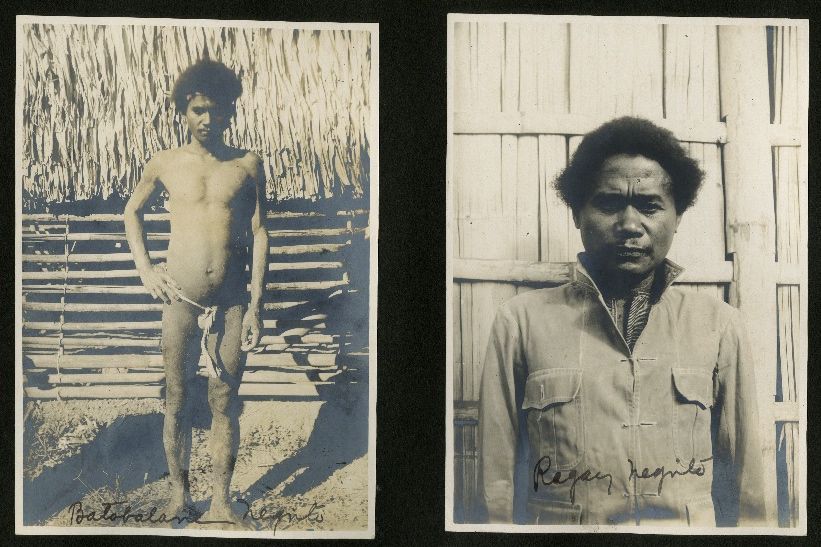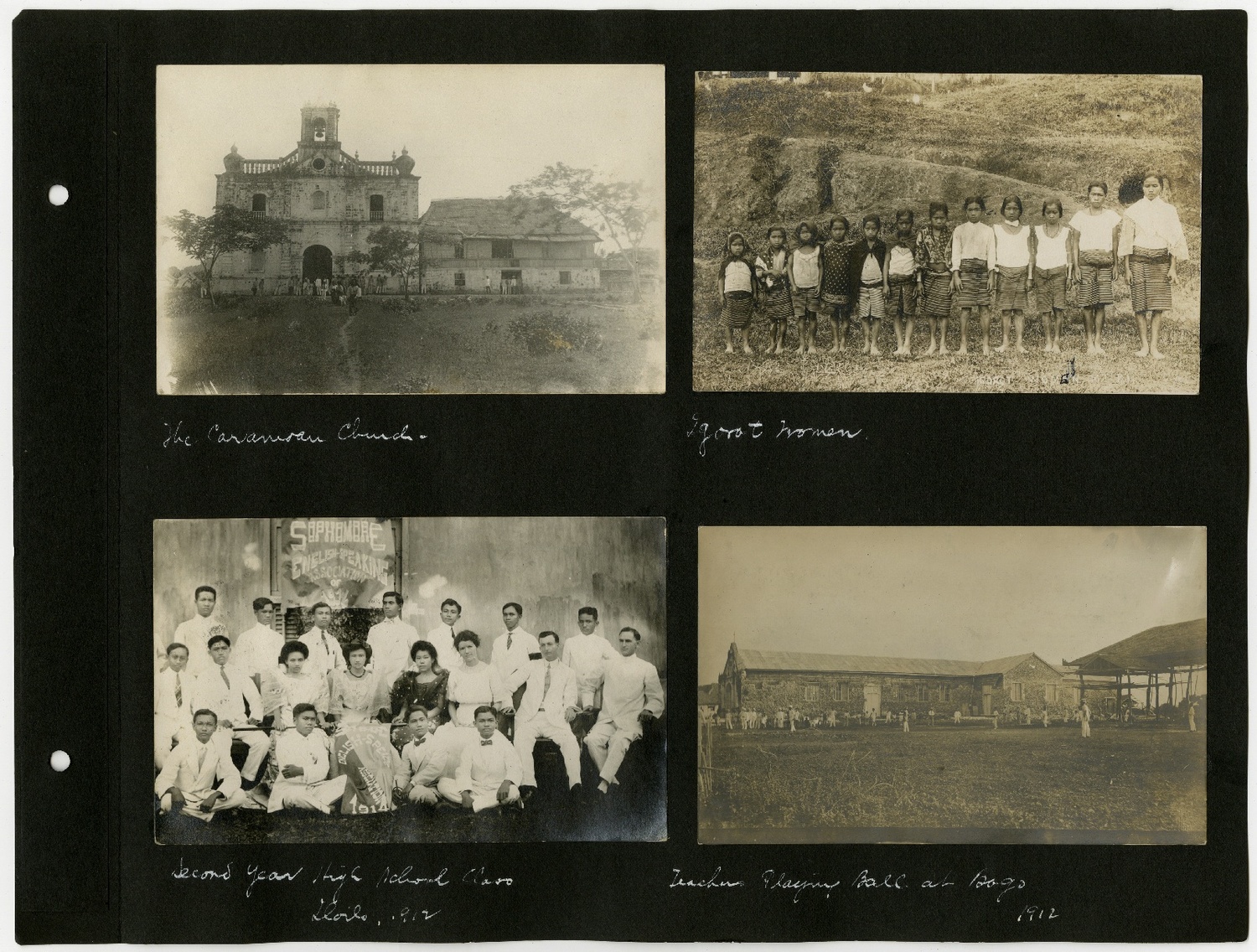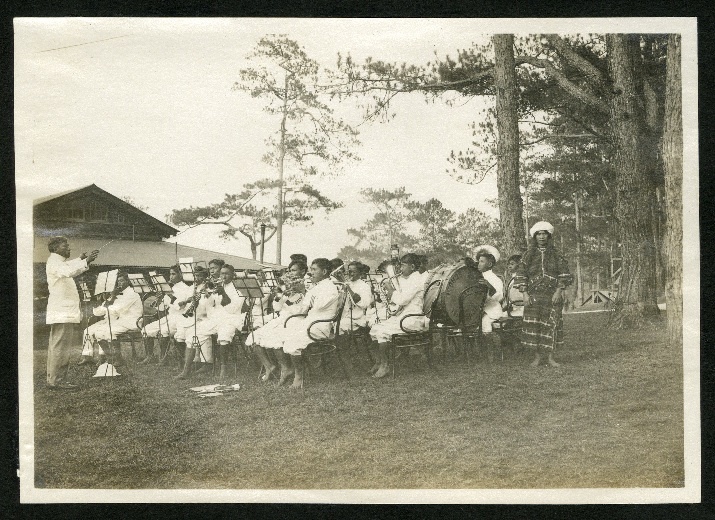IV. Capturing Images of Progress
American colonial photography in the Philippines, after a decade of American rule, offered contradictory views of the Filipinos' "progress." While the colonizers needed to convey the image of success of their colonial project, there was a desire to limit the extent to which the Filipino could be fully "Westernized." In Crone's 1926 speech to the Commission on the Philippines, in which he addresses the question of Philippine independence, he opposed it, describing the Islands as "the child who looks forward to the time he or she will no longer be under parental restraint." The American colonizers frequently used the parent-child trope in characterizing their role in the Philippines and relationship with the population. Crone's photographs reflect this contradictory relationship in which the "parent" has taught the child, but the child still requires parental guidance and supervision.
In this photograph (undated at an unknown locale), a school's band performs—presumably an American piece, as such music was often taught in Philippine schools. The students are dressed in white band uniforms, though they perform barefoot. In the foreground, a young woman dressed in clothing of the indigenous population native to that area stands in front of the uniformed school band in what looks like a posed stance. This kind of cultural mish-mash—that is, juxtapositions of children in western clothing versus those in indigenous clothing, or children participating in outdoor activities organized by the schools versus children on the street—are common in Crone's photography collections, suggesting both undeniable "progress" and the need to continue schooling more Filipino children. The staging effect in this photograph is striking: it seems as if the young woman had been told to stand there for the sake of providing the visual contrast of her indigenous dress against the band's white uniform. Crone's photograph thus recreates a "before and after" effect in one and the same picture.

Caption left: "Batobalani Negrito." Right:"Ragay Negrito." Black and white photographs. Album #2, Crone Mss.
Such "before and after" shots were popularized by anthropologist Dean C. Worcester. The most famous examples from Worcester's archive are "Educational Value of the Constabulary"—which shows three photographs of a Bontoc Igorot man first in his indigenous dress and long hair, then in a white suit and his hair contained in a hat, and finally in a military uniform and short hair—and "The Metamorphosis of a Bontoc Igorot," which first shows a young Igorot boy in indigenous dress and then, in a full body portrait of him taken nine years later, in a white suit. Crone's version of the "before and after" visual trope juxtaposes a photograph of a Negrito man in indigenous dress with a portrait of a Negrito man in Western-style clothing. Interestingly, in order to keep in line with the trope, Crone has posted photographs of two different men. The man on the left is from Batobalani, and the one on the right is from Ragay, two different cities in the Bicol Region, one located in Camarines Norte the other in Camarines Sur. A quick glance at the photographs makes it easy to mistake them as the same man—which seems to have been Crone's intention in placing them side by side in order to convey to his viewers the image of progress

Caption top left: "Caramoan Church." Top right:"Igorot Women." Bottom left: "Second Year High School Class Iloilo, 1912." Bottom right: "Teachers Playing Ball at Bogo, 1912." Black and white photographs. Album #1, Crone Mss.
Crone's arrangement of his albums' photographs reveals his interest in their pages' aesthetic quality. In this example of a full page from an album, he achieves diagonal symmetry. The two landscapes mirror each other the same way the two group portraits in the lower left and upper right sections of the page do. Just as he was willing to suspend geographical consistency in the Negrito men's "before and after" photographs, he was ready to be just as crafty in this page's the selection of images to demonstrate the "progress, but not progress enough" theme. The bottom left photo is of the Iloilo sophomore class English-Speaking Association (Crone dates the photo 1912, but the banner reads 1915). This photograph follows the familiar Western-style group arrangement and posing with the relaxed students arranged in three rows. They are dressed in Western-style clothing, the men in white suits and the women in Spanish-style dresses commonly worn by the women of the Filipino elite. The photo's mirror image in the top right section of the page, however, depicts a very different scene. A number of young Igorot girls stand in one line, staged and stiff, arranged from shortest to tallest—an arrangement that emphasizes their physiological differences, reminiscent of the photographs used for anthropological purposes. They wear indigenous clothing; though as the girls get taller, their tops appear to be more Western-styled. The backdrop does not feature a banner in a sterile school environment, but instead the natural setting of a grassy hill. Note the geographical disparity between these two photographs. The high school photograph's setting, Iloilo, is in the central Visayan Region of the Philippines on Panay Island, whereas the subjects of the other group photo, Igorots, are indigenous to the northern mountain regions of the Philippines' most northern island, Luzon. One can imagine Crone to be saying, "While there are English-Speaking Associations in Iloilo high schools, there are still youths far from such civilized achievement—more work needs to be done! There is still much more the child must to learn from the parent!"

